New zealand’s strategy for globlization PDF
VerifiedAdded on 2021/11/17
|15
|4005
|51
AI Summary
Contribute Materials
Your contribution can guide someone’s learning journey. Share your
documents today.
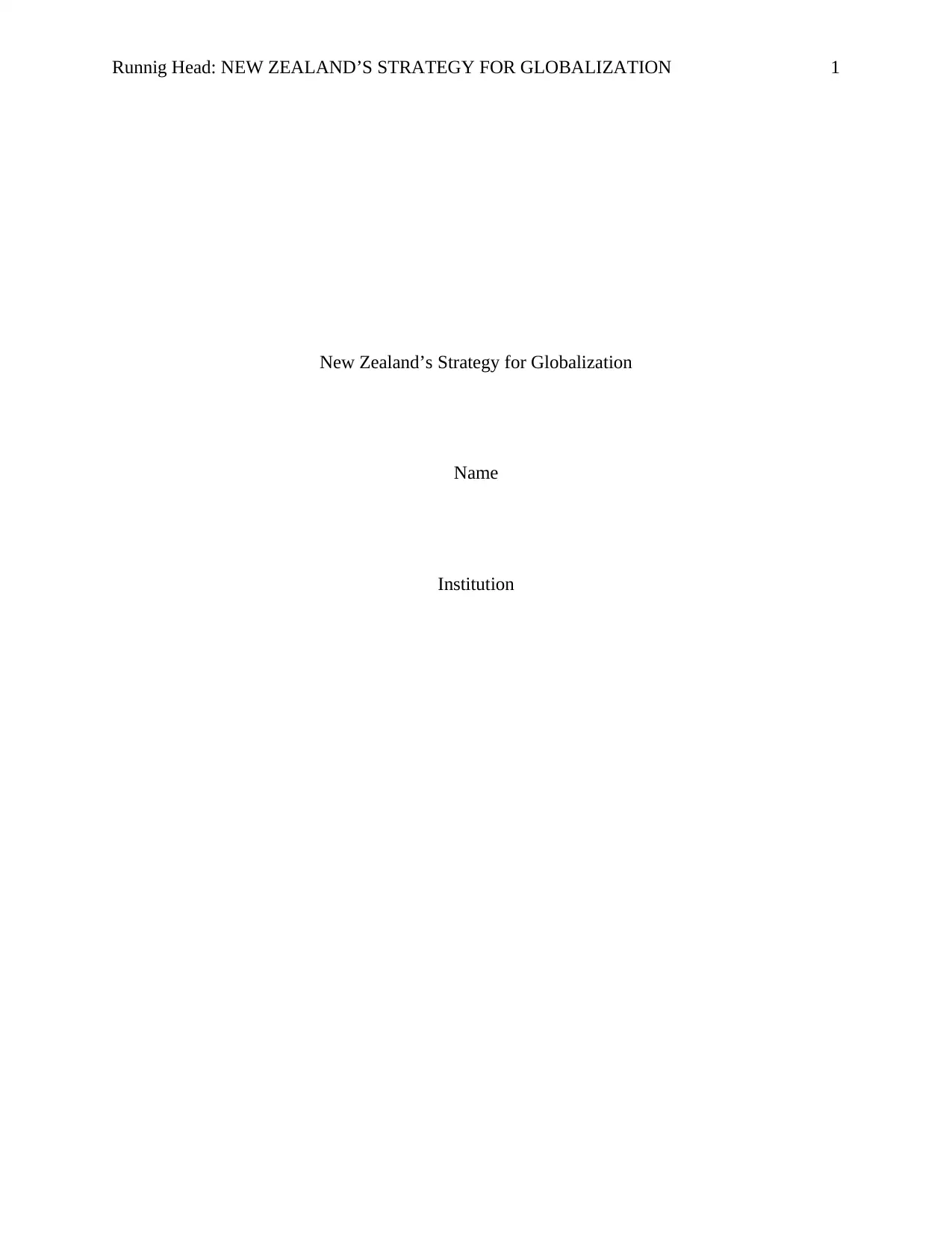
Runnig Head: NEW ZEALAND’S STRATEGY FOR GLOBALIZATION 1
New Zealand’s Strategy for Globalization
Name
Institution
New Zealand’s Strategy for Globalization
Name
Institution
Secure Best Marks with AI Grader
Need help grading? Try our AI Grader for instant feedback on your assignments.
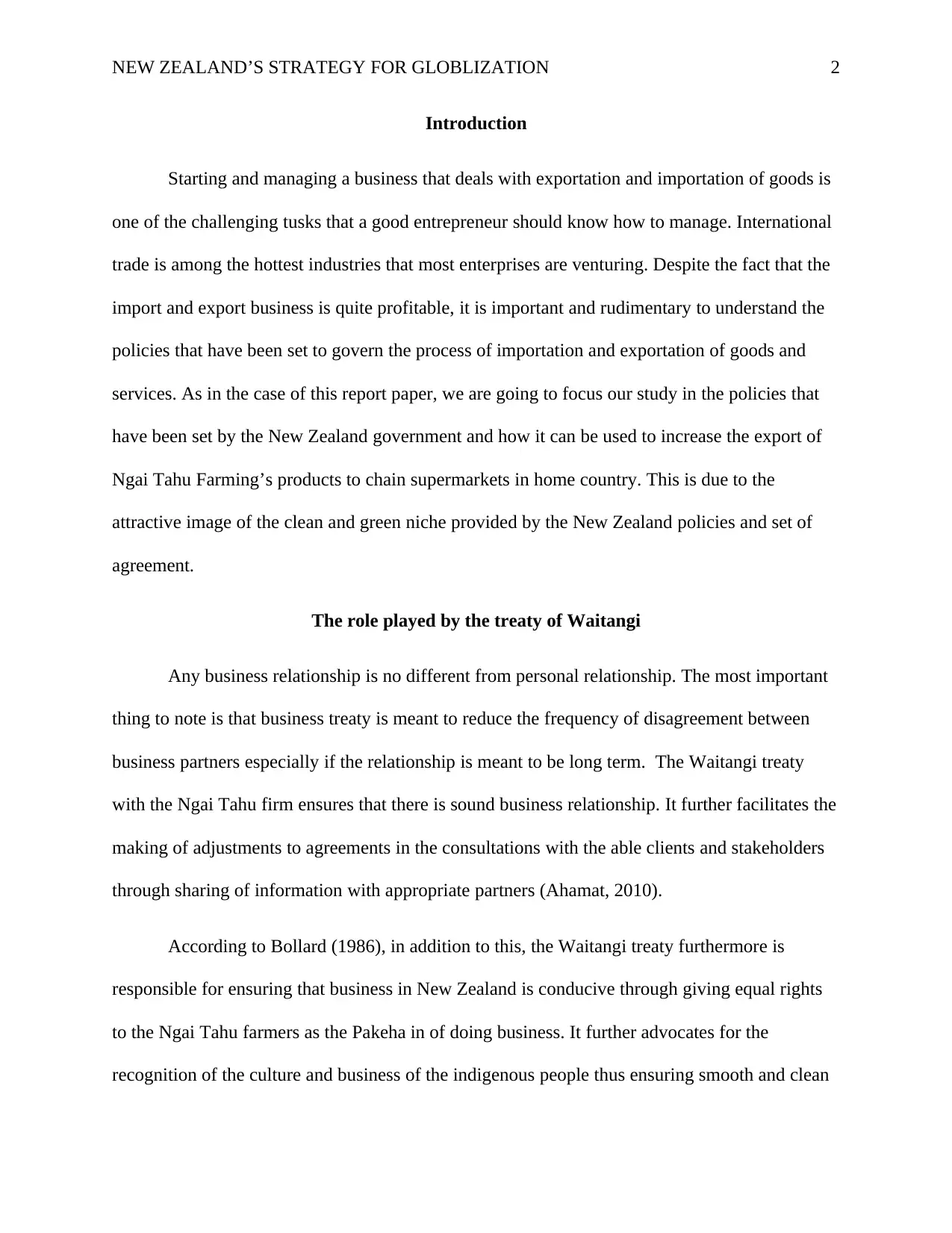
NEW ZEALAND’S STRATEGY FOR GLOBLIZATION 2
Introduction
Starting and managing a business that deals with exportation and importation of goods is
one of the challenging tusks that a good entrepreneur should know how to manage. International
trade is among the hottest industries that most enterprises are venturing. Despite the fact that the
import and export business is quite profitable, it is important and rudimentary to understand the
policies that have been set to govern the process of importation and exportation of goods and
services. As in the case of this report paper, we are going to focus our study in the policies that
have been set by the New Zealand government and how it can be used to increase the export of
Ngai Tahu Farming’s products to chain supermarkets in home country. This is due to the
attractive image of the clean and green niche provided by the New Zealand policies and set of
agreement.
The role played by the treaty of Waitangi
Any business relationship is no different from personal relationship. The most important
thing to note is that business treaty is meant to reduce the frequency of disagreement between
business partners especially if the relationship is meant to be long term. The Waitangi treaty
with the Ngai Tahu firm ensures that there is sound business relationship. It further facilitates the
making of adjustments to agreements in the consultations with the able clients and stakeholders
through sharing of information with appropriate partners (Ahamat, 2010).
According to Bollard (1986), in addition to this, the Waitangi treaty furthermore is
responsible for ensuring that business in New Zealand is conducive through giving equal rights
to the Ngai Tahu farmers as the Pakeha in of doing business. It further advocates for the
recognition of the culture and business of the indigenous people thus ensuring smooth and clean
Introduction
Starting and managing a business that deals with exportation and importation of goods is
one of the challenging tusks that a good entrepreneur should know how to manage. International
trade is among the hottest industries that most enterprises are venturing. Despite the fact that the
import and export business is quite profitable, it is important and rudimentary to understand the
policies that have been set to govern the process of importation and exportation of goods and
services. As in the case of this report paper, we are going to focus our study in the policies that
have been set by the New Zealand government and how it can be used to increase the export of
Ngai Tahu Farming’s products to chain supermarkets in home country. This is due to the
attractive image of the clean and green niche provided by the New Zealand policies and set of
agreement.
The role played by the treaty of Waitangi
Any business relationship is no different from personal relationship. The most important
thing to note is that business treaty is meant to reduce the frequency of disagreement between
business partners especially if the relationship is meant to be long term. The Waitangi treaty
with the Ngai Tahu firm ensures that there is sound business relationship. It further facilitates the
making of adjustments to agreements in the consultations with the able clients and stakeholders
through sharing of information with appropriate partners (Ahamat, 2010).
According to Bollard (1986), in addition to this, the Waitangi treaty furthermore is
responsible for ensuring that business in New Zealand is conducive through giving equal rights
to the Ngai Tahu farmers as the Pakeha in of doing business. It further advocates for the
recognition of the culture and business of the indigenous people thus ensuring smooth and clean
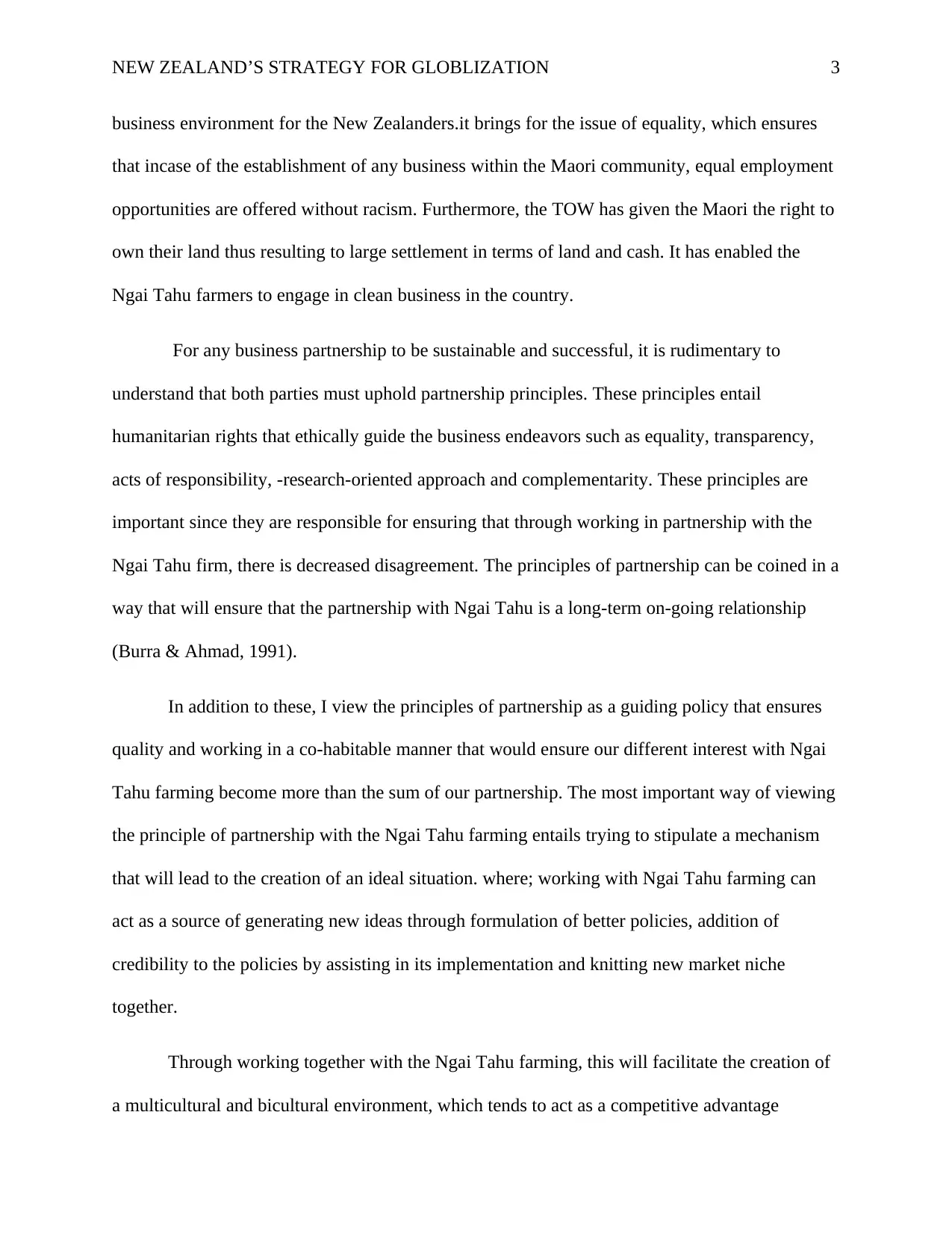
NEW ZEALAND’S STRATEGY FOR GLOBLIZATION 3
business environment for the New Zealanders.it brings for the issue of equality, which ensures
that incase of the establishment of any business within the Maori community, equal employment
opportunities are offered without racism. Furthermore, the TOW has given the Maori the right to
own their land thus resulting to large settlement in terms of land and cash. It has enabled the
Ngai Tahu farmers to engage in clean business in the country.
For any business partnership to be sustainable and successful, it is rudimentary to
understand that both parties must uphold partnership principles. These principles entail
humanitarian rights that ethically guide the business endeavors such as equality, transparency,
acts of responsibility, -research-oriented approach and complementarity. These principles are
important since they are responsible for ensuring that through working in partnership with the
Ngai Tahu firm, there is decreased disagreement. The principles of partnership can be coined in a
way that will ensure that the partnership with Ngai Tahu is a long-term on-going relationship
(Burra & Ahmad, 1991).
In addition to these, I view the principles of partnership as a guiding policy that ensures
quality and working in a co-habitable manner that would ensure our different interest with Ngai
Tahu farming become more than the sum of our partnership. The most important way of viewing
the principle of partnership with the Ngai Tahu farming entails trying to stipulate a mechanism
that will lead to the creation of an ideal situation. where; working with Ngai Tahu farming can
act as a source of generating new ideas through formulation of better policies, addition of
credibility to the policies by assisting in its implementation and knitting new market niche
together.
Through working together with the Ngai Tahu farming, this will facilitate the creation of
a multicultural and bicultural environment, which tends to act as a competitive advantage
business environment for the New Zealanders.it brings for the issue of equality, which ensures
that incase of the establishment of any business within the Maori community, equal employment
opportunities are offered without racism. Furthermore, the TOW has given the Maori the right to
own their land thus resulting to large settlement in terms of land and cash. It has enabled the
Ngai Tahu farmers to engage in clean business in the country.
For any business partnership to be sustainable and successful, it is rudimentary to
understand that both parties must uphold partnership principles. These principles entail
humanitarian rights that ethically guide the business endeavors such as equality, transparency,
acts of responsibility, -research-oriented approach and complementarity. These principles are
important since they are responsible for ensuring that through working in partnership with the
Ngai Tahu firm, there is decreased disagreement. The principles of partnership can be coined in a
way that will ensure that the partnership with Ngai Tahu is a long-term on-going relationship
(Burra & Ahmad, 1991).
In addition to these, I view the principles of partnership as a guiding policy that ensures
quality and working in a co-habitable manner that would ensure our different interest with Ngai
Tahu farming become more than the sum of our partnership. The most important way of viewing
the principle of partnership with the Ngai Tahu farming entails trying to stipulate a mechanism
that will lead to the creation of an ideal situation. where; working with Ngai Tahu farming can
act as a source of generating new ideas through formulation of better policies, addition of
credibility to the policies by assisting in its implementation and knitting new market niche
together.
Through working together with the Ngai Tahu farming, this will facilitate the creation of
a multicultural and bicultural environment, which tends to act as a competitive advantage
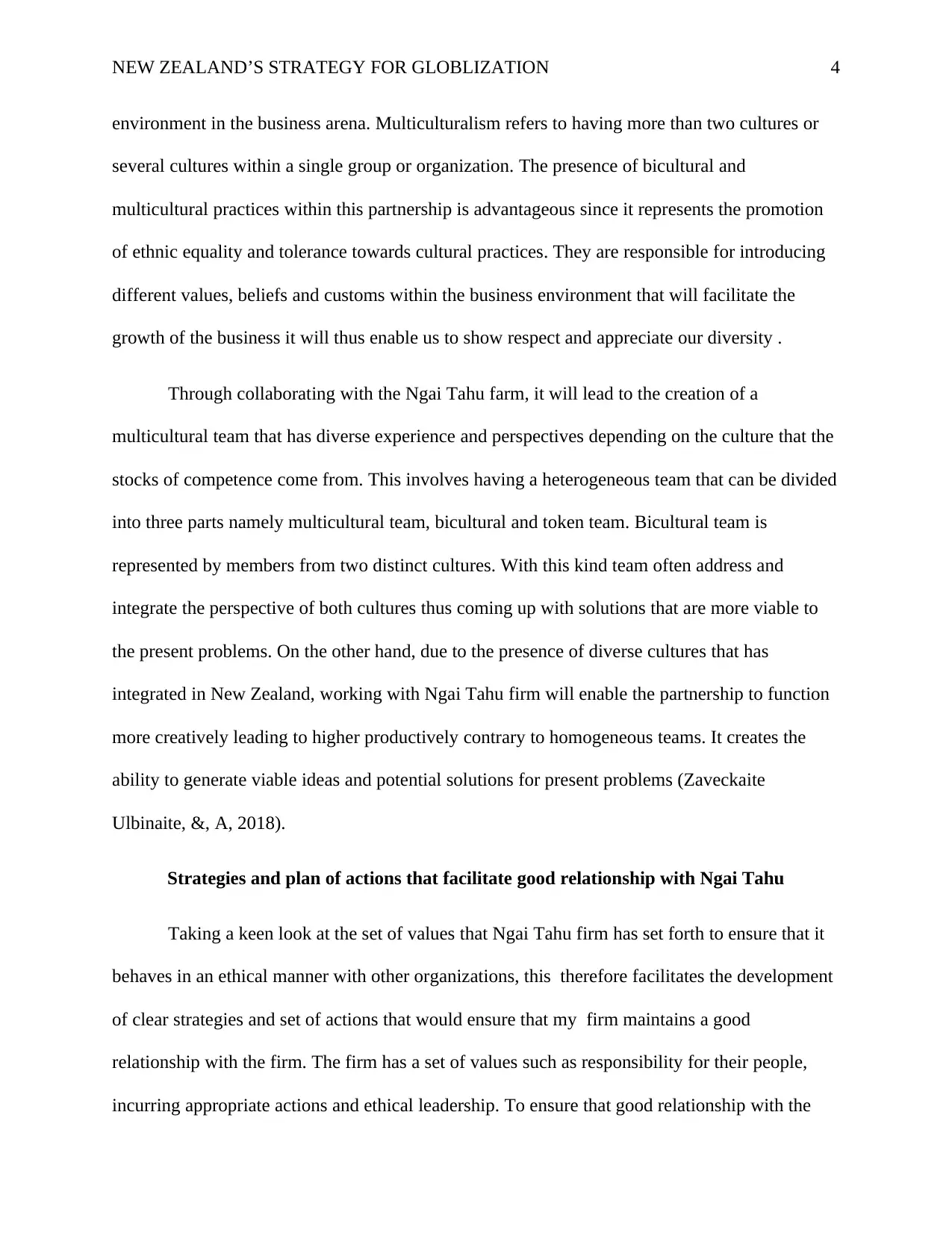
NEW ZEALAND’S STRATEGY FOR GLOBLIZATION 4
environment in the business arena. Multiculturalism refers to having more than two cultures or
several cultures within a single group or organization. The presence of bicultural and
multicultural practices within this partnership is advantageous since it represents the promotion
of ethnic equality and tolerance towards cultural practices. They are responsible for introducing
different values, beliefs and customs within the business environment that will facilitate the
growth of the business it will thus enable us to show respect and appreciate our diversity .
Through collaborating with the Ngai Tahu farm, it will lead to the creation of a
multicultural team that has diverse experience and perspectives depending on the culture that the
stocks of competence come from. This involves having a heterogeneous team that can be divided
into three parts namely multicultural team, bicultural and token team. Bicultural team is
represented by members from two distinct cultures. With this kind team often address and
integrate the perspective of both cultures thus coming up with solutions that are more viable to
the present problems. On the other hand, due to the presence of diverse cultures that has
integrated in New Zealand, working with Ngai Tahu firm will enable the partnership to function
more creatively leading to higher productively contrary to homogeneous teams. It creates the
ability to generate viable ideas and potential solutions for present problems (Zaveckaite
Ulbinaite, &, A, 2018).
Strategies and plan of actions that facilitate good relationship with Ngai Tahu
Taking a keen look at the set of values that Ngai Tahu firm has set forth to ensure that it
behaves in an ethical manner with other organizations, this therefore facilitates the development
of clear strategies and set of actions that would ensure that my firm maintains a good
relationship with the firm. The firm has a set of values such as responsibility for their people,
incurring appropriate actions and ethical leadership. To ensure that good relationship with the
environment in the business arena. Multiculturalism refers to having more than two cultures or
several cultures within a single group or organization. The presence of bicultural and
multicultural practices within this partnership is advantageous since it represents the promotion
of ethnic equality and tolerance towards cultural practices. They are responsible for introducing
different values, beliefs and customs within the business environment that will facilitate the
growth of the business it will thus enable us to show respect and appreciate our diversity .
Through collaborating with the Ngai Tahu farm, it will lead to the creation of a
multicultural team that has diverse experience and perspectives depending on the culture that the
stocks of competence come from. This involves having a heterogeneous team that can be divided
into three parts namely multicultural team, bicultural and token team. Bicultural team is
represented by members from two distinct cultures. With this kind team often address and
integrate the perspective of both cultures thus coming up with solutions that are more viable to
the present problems. On the other hand, due to the presence of diverse cultures that has
integrated in New Zealand, working with Ngai Tahu firm will enable the partnership to function
more creatively leading to higher productively contrary to homogeneous teams. It creates the
ability to generate viable ideas and potential solutions for present problems (Zaveckaite
Ulbinaite, &, A, 2018).
Strategies and plan of actions that facilitate good relationship with Ngai Tahu
Taking a keen look at the set of values that Ngai Tahu firm has set forth to ensure that it
behaves in an ethical manner with other organizations, this therefore facilitates the development
of clear strategies and set of actions that would ensure that my firm maintains a good
relationship with the firm. The firm has a set of values such as responsibility for their people,
incurring appropriate actions and ethical leadership. To ensure that good relationship with the
Secure Best Marks with AI Grader
Need help grading? Try our AI Grader for instant feedback on your assignments.
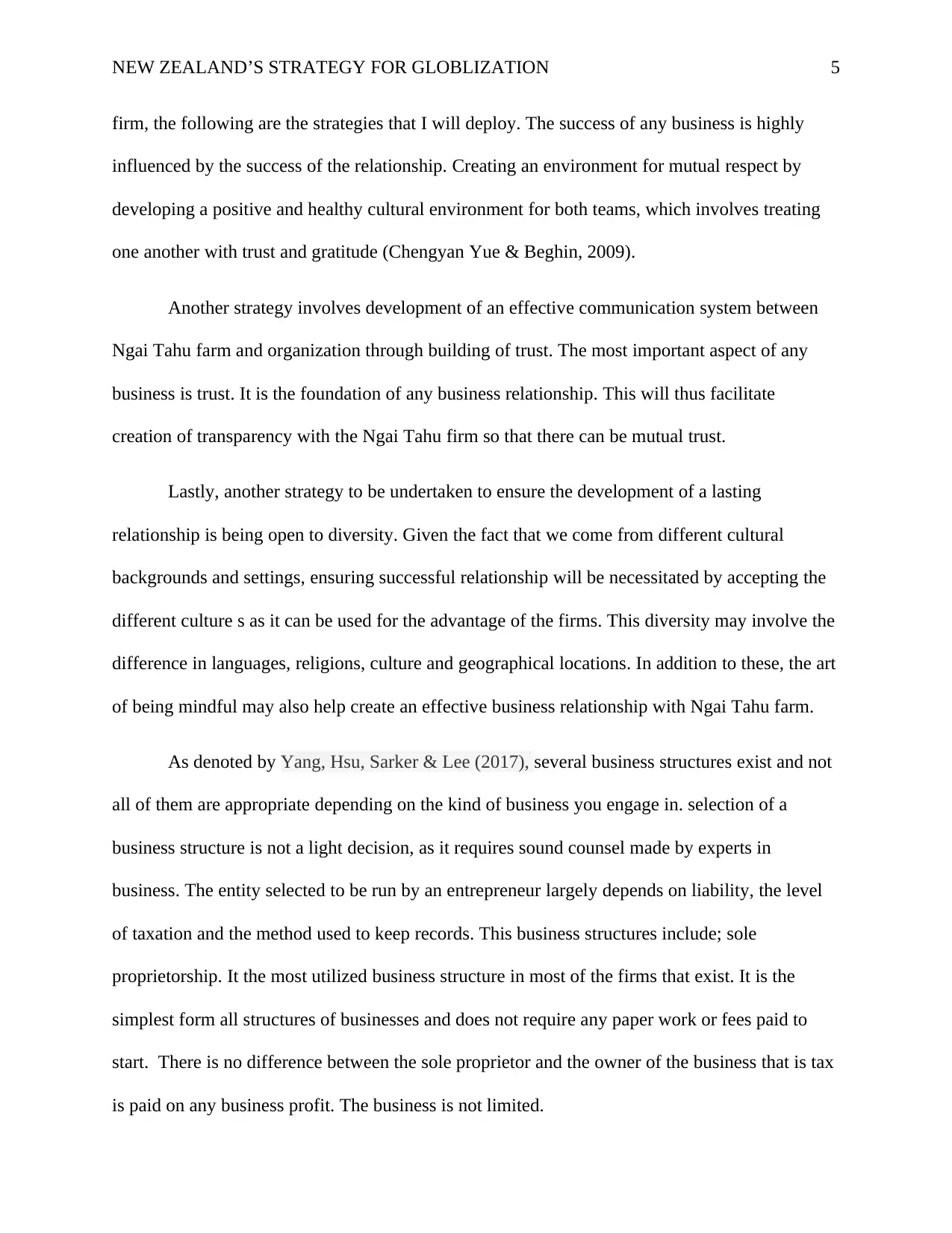
NEW ZEALAND’S STRATEGY FOR GLOBLIZATION 5
firm, the following are the strategies that I will deploy. The success of any business is highly
influenced by the success of the relationship. Creating an environment for mutual respect by
developing a positive and healthy cultural environment for both teams, which involves treating
one another with trust and gratitude (Chengyan Yue & Beghin, 2009).
Another strategy involves development of an effective communication system between
Ngai Tahu farm and organization through building of trust. The most important aspect of any
business is trust. It is the foundation of any business relationship. This will thus facilitate
creation of transparency with the Ngai Tahu firm so that there can be mutual trust.
Lastly, another strategy to be undertaken to ensure the development of a lasting
relationship is being open to diversity. Given the fact that we come from different cultural
backgrounds and settings, ensuring successful relationship will be necessitated by accepting the
different culture s as it can be used for the advantage of the firms. This diversity may involve the
difference in languages, religions, culture and geographical locations. In addition to these, the art
of being mindful may also help create an effective business relationship with Ngai Tahu farm.
As denoted by Yang, Hsu, Sarker & Lee (2017), several business structures exist and not
all of them are appropriate depending on the kind of business you engage in. selection of a
business structure is not a light decision, as it requires sound counsel made by experts in
business. The entity selected to be run by an entrepreneur largely depends on liability, the level
of taxation and the method used to keep records. This business structures include; sole
proprietorship. It the most utilized business structure in most of the firms that exist. It is the
simplest form all structures of businesses and does not require any paper work or fees paid to
start. There is no difference between the sole proprietor and the owner of the business that is tax
is paid on any business profit. The business is not limited.
firm, the following are the strategies that I will deploy. The success of any business is highly
influenced by the success of the relationship. Creating an environment for mutual respect by
developing a positive and healthy cultural environment for both teams, which involves treating
one another with trust and gratitude (Chengyan Yue & Beghin, 2009).
Another strategy involves development of an effective communication system between
Ngai Tahu farm and organization through building of trust. The most important aspect of any
business is trust. It is the foundation of any business relationship. This will thus facilitate
creation of transparency with the Ngai Tahu firm so that there can be mutual trust.
Lastly, another strategy to be undertaken to ensure the development of a lasting
relationship is being open to diversity. Given the fact that we come from different cultural
backgrounds and settings, ensuring successful relationship will be necessitated by accepting the
different culture s as it can be used for the advantage of the firms. This diversity may involve the
difference in languages, religions, culture and geographical locations. In addition to these, the art
of being mindful may also help create an effective business relationship with Ngai Tahu farm.
As denoted by Yang, Hsu, Sarker & Lee (2017), several business structures exist and not
all of them are appropriate depending on the kind of business you engage in. selection of a
business structure is not a light decision, as it requires sound counsel made by experts in
business. The entity selected to be run by an entrepreneur largely depends on liability, the level
of taxation and the method used to keep records. This business structures include; sole
proprietorship. It the most utilized business structure in most of the firms that exist. It is the
simplest form all structures of businesses and does not require any paper work or fees paid to
start. There is no difference between the sole proprietor and the owner of the business that is tax
is paid on any business profit. The business is not limited.
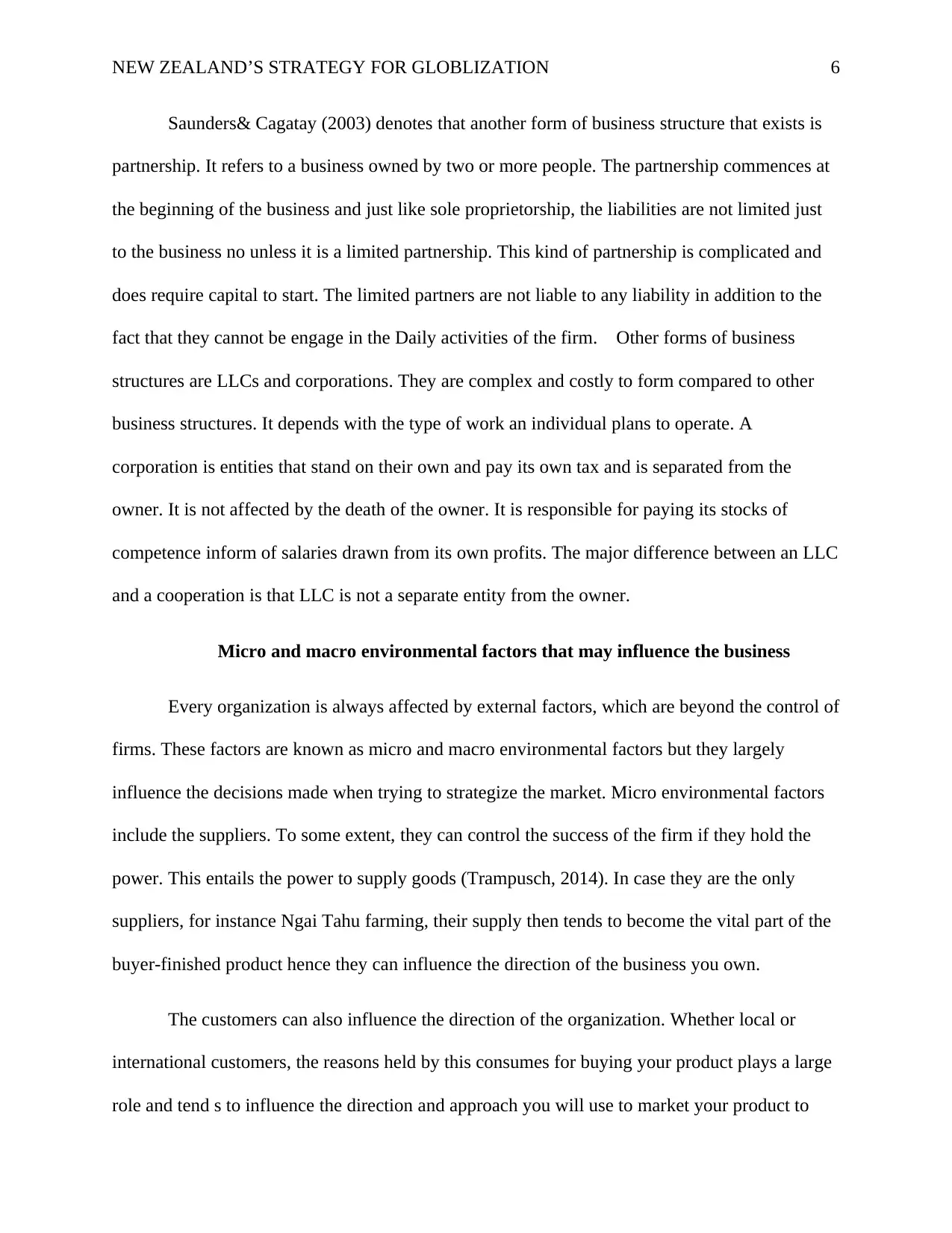
NEW ZEALAND’S STRATEGY FOR GLOBLIZATION 6
Saunders& Cagatay (2003) denotes that another form of business structure that exists is
partnership. It refers to a business owned by two or more people. The partnership commences at
the beginning of the business and just like sole proprietorship, the liabilities are not limited just
to the business no unless it is a limited partnership. This kind of partnership is complicated and
does require capital to start. The limited partners are not liable to any liability in addition to the
fact that they cannot be engage in the Daily activities of the firm. Other forms of business
structures are LLCs and corporations. They are complex and costly to form compared to other
business structures. It depends with the type of work an individual plans to operate. A
corporation is entities that stand on their own and pay its own tax and is separated from the
owner. It is not affected by the death of the owner. It is responsible for paying its stocks of
competence inform of salaries drawn from its own profits. The major difference between an LLC
and a cooperation is that LLC is not a separate entity from the owner.
Micro and macro environmental factors that may influence the business
Every organization is always affected by external factors, which are beyond the control of
firms. These factors are known as micro and macro environmental factors but they largely
influence the decisions made when trying to strategize the market. Micro environmental factors
include the suppliers. To some extent, they can control the success of the firm if they hold the
power. This entails the power to supply goods (Trampusch, 2014). In case they are the only
suppliers, for instance Ngai Tahu farming, their supply then tends to become the vital part of the
buyer-finished product hence they can influence the direction of the business you own.
The customers can also influence the direction of the organization. Whether local or
international customers, the reasons held by this consumes for buying your product plays a large
role and tend s to influence the direction and approach you will use to market your product to
Saunders& Cagatay (2003) denotes that another form of business structure that exists is
partnership. It refers to a business owned by two or more people. The partnership commences at
the beginning of the business and just like sole proprietorship, the liabilities are not limited just
to the business no unless it is a limited partnership. This kind of partnership is complicated and
does require capital to start. The limited partners are not liable to any liability in addition to the
fact that they cannot be engage in the Daily activities of the firm. Other forms of business
structures are LLCs and corporations. They are complex and costly to form compared to other
business structures. It depends with the type of work an individual plans to operate. A
corporation is entities that stand on their own and pay its own tax and is separated from the
owner. It is not affected by the death of the owner. It is responsible for paying its stocks of
competence inform of salaries drawn from its own profits. The major difference between an LLC
and a cooperation is that LLC is not a separate entity from the owner.
Micro and macro environmental factors that may influence the business
Every organization is always affected by external factors, which are beyond the control of
firms. These factors are known as micro and macro environmental factors but they largely
influence the decisions made when trying to strategize the market. Micro environmental factors
include the suppliers. To some extent, they can control the success of the firm if they hold the
power. This entails the power to supply goods (Trampusch, 2014). In case they are the only
suppliers, for instance Ngai Tahu farming, their supply then tends to become the vital part of the
buyer-finished product hence they can influence the direction of the business you own.
The customers can also influence the direction of the organization. Whether local or
international customers, the reasons held by this consumes for buying your product plays a large
role and tend s to influence the direction and approach you will use to market your product to
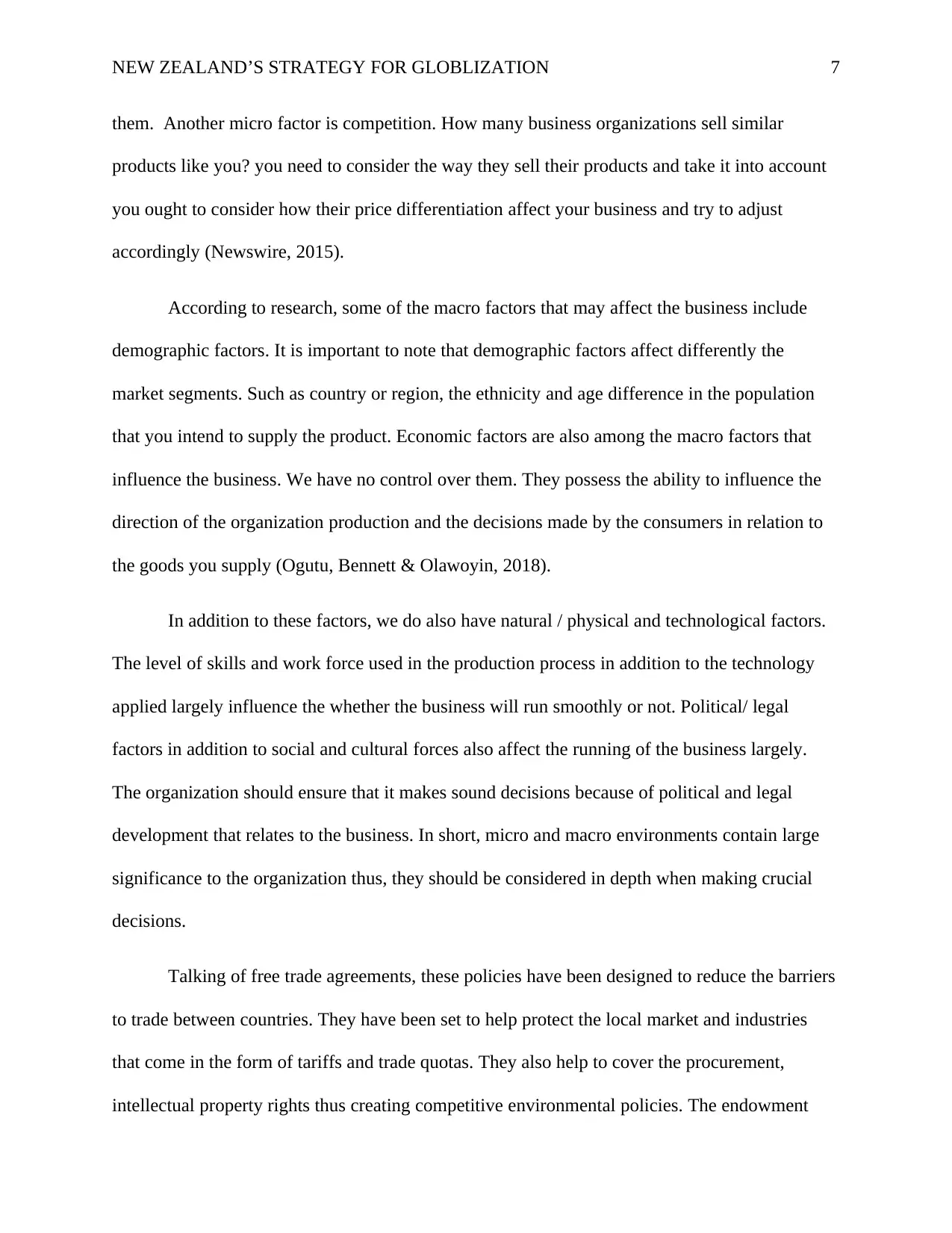
NEW ZEALAND’S STRATEGY FOR GLOBLIZATION 7
them. Another micro factor is competition. How many business organizations sell similar
products like you? you need to consider the way they sell their products and take it into account
you ought to consider how their price differentiation affect your business and try to adjust
accordingly (Newswire, 2015).
According to research, some of the macro factors that may affect the business include
demographic factors. It is important to note that demographic factors affect differently the
market segments. Such as country or region, the ethnicity and age difference in the population
that you intend to supply the product. Economic factors are also among the macro factors that
influence the business. We have no control over them. They possess the ability to influence the
direction of the organization production and the decisions made by the consumers in relation to
the goods you supply (Ogutu, Bennett & Olawoyin, 2018).
In addition to these factors, we do also have natural / physical and technological factors.
The level of skills and work force used in the production process in addition to the technology
applied largely influence the whether the business will run smoothly or not. Political/ legal
factors in addition to social and cultural forces also affect the running of the business largely.
The organization should ensure that it makes sound decisions because of political and legal
development that relates to the business. In short, micro and macro environments contain large
significance to the organization thus, they should be considered in depth when making crucial
decisions.
Talking of free trade agreements, these policies have been designed to reduce the barriers
to trade between countries. They have been set to help protect the local market and industries
that come in the form of tariffs and trade quotas. They also help to cover the procurement,
intellectual property rights thus creating competitive environmental policies. The endowment
them. Another micro factor is competition. How many business organizations sell similar
products like you? you need to consider the way they sell their products and take it into account
you ought to consider how their price differentiation affect your business and try to adjust
accordingly (Newswire, 2015).
According to research, some of the macro factors that may affect the business include
demographic factors. It is important to note that demographic factors affect differently the
market segments. Such as country or region, the ethnicity and age difference in the population
that you intend to supply the product. Economic factors are also among the macro factors that
influence the business. We have no control over them. They possess the ability to influence the
direction of the organization production and the decisions made by the consumers in relation to
the goods you supply (Ogutu, Bennett & Olawoyin, 2018).
In addition to these factors, we do also have natural / physical and technological factors.
The level of skills and work force used in the production process in addition to the technology
applied largely influence the whether the business will run smoothly or not. Political/ legal
factors in addition to social and cultural forces also affect the running of the business largely.
The organization should ensure that it makes sound decisions because of political and legal
development that relates to the business. In short, micro and macro environments contain large
significance to the organization thus, they should be considered in depth when making crucial
decisions.
Talking of free trade agreements, these policies have been designed to reduce the barriers
to trade between countries. They have been set to help protect the local market and industries
that come in the form of tariffs and trade quotas. They also help to cover the procurement,
intellectual property rights thus creating competitive environmental policies. The endowment
Paraphrase This Document
Need a fresh take? Get an instant paraphrase of this document with our AI Paraphraser
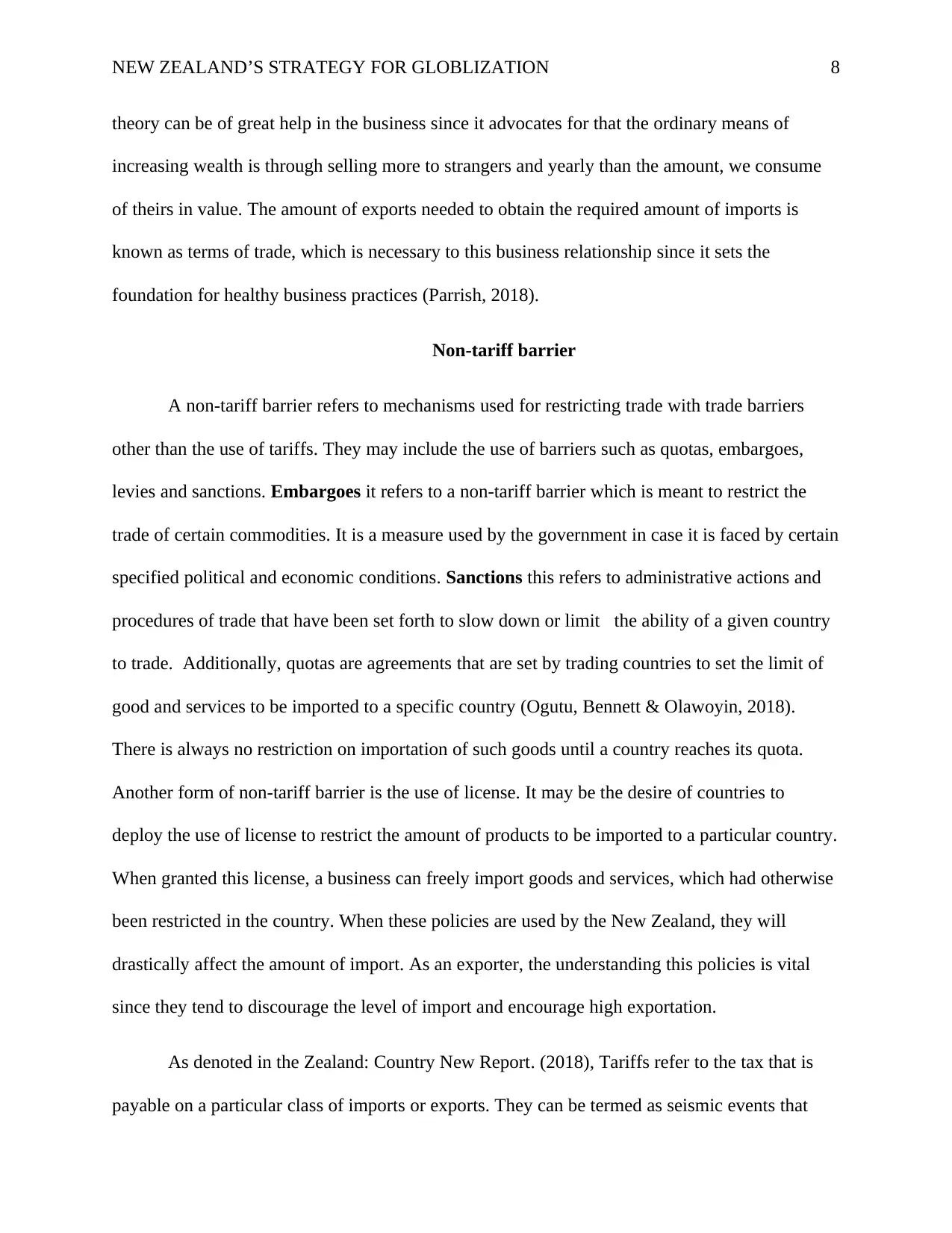
NEW ZEALAND’S STRATEGY FOR GLOBLIZATION 8
theory can be of great help in the business since it advocates for that the ordinary means of
increasing wealth is through selling more to strangers and yearly than the amount, we consume
of theirs in value. The amount of exports needed to obtain the required amount of imports is
known as terms of trade, which is necessary to this business relationship since it sets the
foundation for healthy business practices (Parrish, 2018).
Non-tariff barrier
A non-tariff barrier refers to mechanisms used for restricting trade with trade barriers
other than the use of tariffs. They may include the use of barriers such as quotas, embargoes,
levies and sanctions. Embargoes it refers to a non-tariff barrier which is meant to restrict the
trade of certain commodities. It is a measure used by the government in case it is faced by certain
specified political and economic conditions. Sanctions this refers to administrative actions and
procedures of trade that have been set forth to slow down or limit the ability of a given country
to trade. Additionally, quotas are agreements that are set by trading countries to set the limit of
good and services to be imported to a specific country (Ogutu, Bennett & Olawoyin, 2018).
There is always no restriction on importation of such goods until a country reaches its quota.
Another form of non-tariff barrier is the use of license. It may be the desire of countries to
deploy the use of license to restrict the amount of products to be imported to a particular country.
When granted this license, a business can freely import goods and services, which had otherwise
been restricted in the country. When these policies are used by the New Zealand, they will
drastically affect the amount of import. As an exporter, the understanding this policies is vital
since they tend to discourage the level of import and encourage high exportation.
As denoted in the Zealand: Country New Report. (2018), Tariffs refer to the tax that is
payable on a particular class of imports or exports. They can be termed as seismic events that
theory can be of great help in the business since it advocates for that the ordinary means of
increasing wealth is through selling more to strangers and yearly than the amount, we consume
of theirs in value. The amount of exports needed to obtain the required amount of imports is
known as terms of trade, which is necessary to this business relationship since it sets the
foundation for healthy business practices (Parrish, 2018).
Non-tariff barrier
A non-tariff barrier refers to mechanisms used for restricting trade with trade barriers
other than the use of tariffs. They may include the use of barriers such as quotas, embargoes,
levies and sanctions. Embargoes it refers to a non-tariff barrier which is meant to restrict the
trade of certain commodities. It is a measure used by the government in case it is faced by certain
specified political and economic conditions. Sanctions this refers to administrative actions and
procedures of trade that have been set forth to slow down or limit the ability of a given country
to trade. Additionally, quotas are agreements that are set by trading countries to set the limit of
good and services to be imported to a specific country (Ogutu, Bennett & Olawoyin, 2018).
There is always no restriction on importation of such goods until a country reaches its quota.
Another form of non-tariff barrier is the use of license. It may be the desire of countries to
deploy the use of license to restrict the amount of products to be imported to a particular country.
When granted this license, a business can freely import goods and services, which had otherwise
been restricted in the country. When these policies are used by the New Zealand, they will
drastically affect the amount of import. As an exporter, the understanding this policies is vital
since they tend to discourage the level of import and encourage high exportation.
As denoted in the Zealand: Country New Report. (2018), Tariffs refer to the tax that is
payable on a particular class of imports or exports. They can be termed as seismic events that
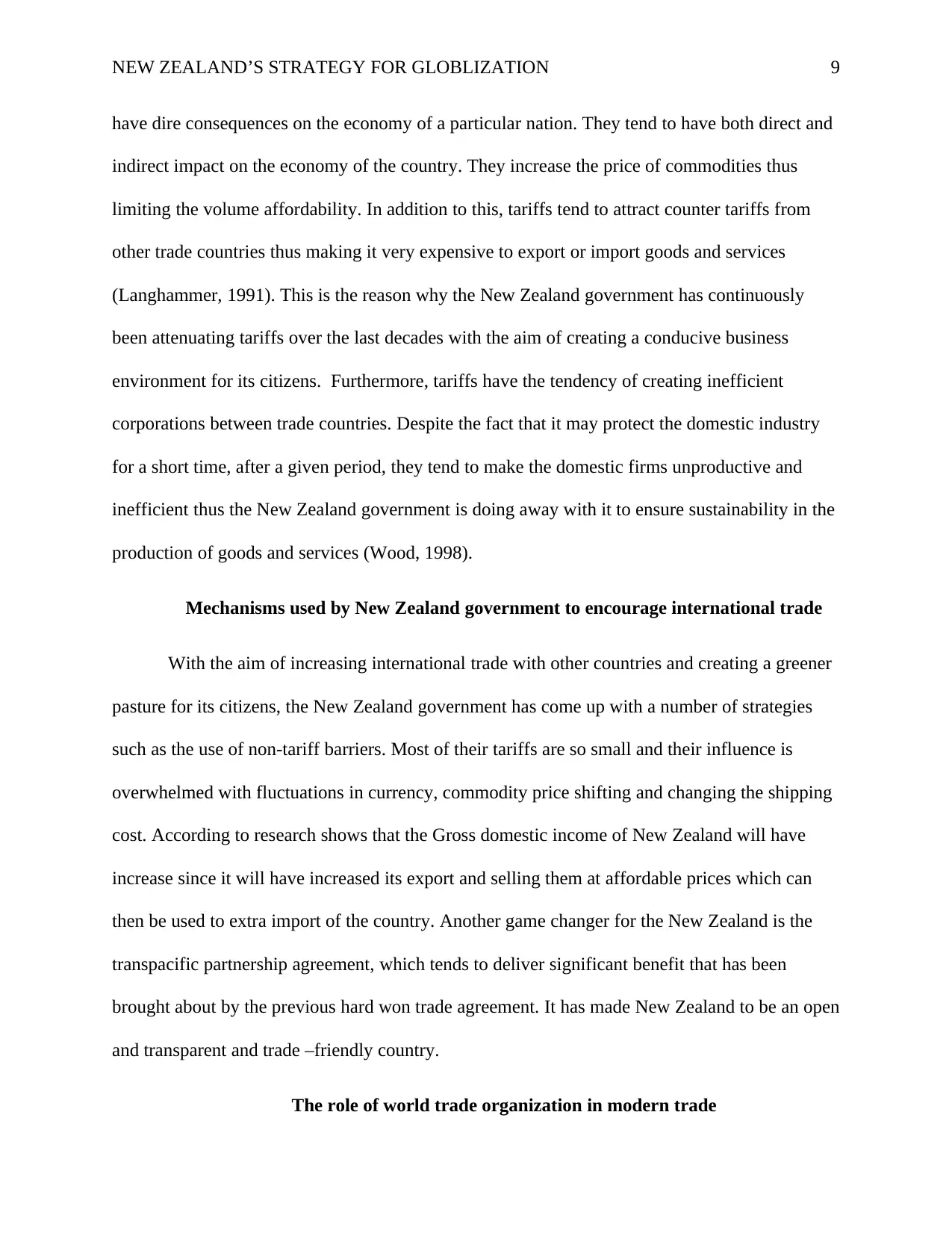
NEW ZEALAND’S STRATEGY FOR GLOBLIZATION 9
have dire consequences on the economy of a particular nation. They tend to have both direct and
indirect impact on the economy of the country. They increase the price of commodities thus
limiting the volume affordability. In addition to this, tariffs tend to attract counter tariffs from
other trade countries thus making it very expensive to export or import goods and services
(Langhammer, 1991). This is the reason why the New Zealand government has continuously
been attenuating tariffs over the last decades with the aim of creating a conducive business
environment for its citizens. Furthermore, tariffs have the tendency of creating inefficient
corporations between trade countries. Despite the fact that it may protect the domestic industry
for a short time, after a given period, they tend to make the domestic firms unproductive and
inefficient thus the New Zealand government is doing away with it to ensure sustainability in the
production of goods and services (Wood, 1998).
Mechanisms used by New Zealand government to encourage international trade
With the aim of increasing international trade with other countries and creating a greener
pasture for its citizens, the New Zealand government has come up with a number of strategies
such as the use of non-tariff barriers. Most of their tariffs are so small and their influence is
overwhelmed with fluctuations in currency, commodity price shifting and changing the shipping
cost. According to research shows that the Gross domestic income of New Zealand will have
increase since it will have increased its export and selling them at affordable prices which can
then be used to extra import of the country. Another game changer for the New Zealand is the
transpacific partnership agreement, which tends to deliver significant benefit that has been
brought about by the previous hard won trade agreement. It has made New Zealand to be an open
and transparent and trade –friendly country.
The role of world trade organization in modern trade
have dire consequences on the economy of a particular nation. They tend to have both direct and
indirect impact on the economy of the country. They increase the price of commodities thus
limiting the volume affordability. In addition to this, tariffs tend to attract counter tariffs from
other trade countries thus making it very expensive to export or import goods and services
(Langhammer, 1991). This is the reason why the New Zealand government has continuously
been attenuating tariffs over the last decades with the aim of creating a conducive business
environment for its citizens. Furthermore, tariffs have the tendency of creating inefficient
corporations between trade countries. Despite the fact that it may protect the domestic industry
for a short time, after a given period, they tend to make the domestic firms unproductive and
inefficient thus the New Zealand government is doing away with it to ensure sustainability in the
production of goods and services (Wood, 1998).
Mechanisms used by New Zealand government to encourage international trade
With the aim of increasing international trade with other countries and creating a greener
pasture for its citizens, the New Zealand government has come up with a number of strategies
such as the use of non-tariff barriers. Most of their tariffs are so small and their influence is
overwhelmed with fluctuations in currency, commodity price shifting and changing the shipping
cost. According to research shows that the Gross domestic income of New Zealand will have
increase since it will have increased its export and selling them at affordable prices which can
then be used to extra import of the country. Another game changer for the New Zealand is the
transpacific partnership agreement, which tends to deliver significant benefit that has been
brought about by the previous hard won trade agreement. It has made New Zealand to be an open
and transparent and trade –friendly country.
The role of world trade organization in modern trade
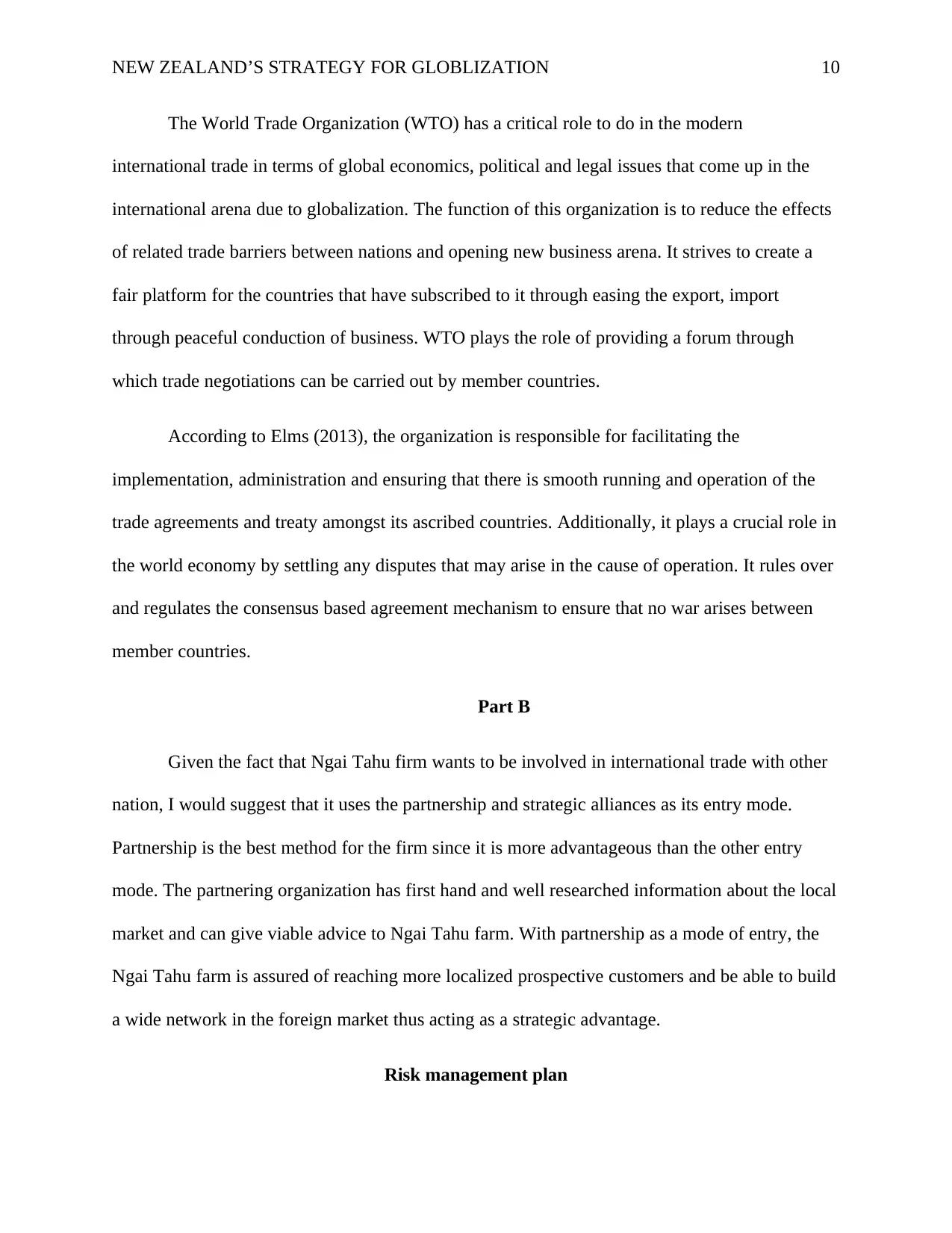
NEW ZEALAND’S STRATEGY FOR GLOBLIZATION 10
The World Trade Organization (WTO) has a critical role to do in the modern
international trade in terms of global economics, political and legal issues that come up in the
international arena due to globalization. The function of this organization is to reduce the effects
of related trade barriers between nations and opening new business arena. It strives to create a
fair platform for the countries that have subscribed to it through easing the export, import
through peaceful conduction of business. WTO plays the role of providing a forum through
which trade negotiations can be carried out by member countries.
According to Elms (2013), the organization is responsible for facilitating the
implementation, administration and ensuring that there is smooth running and operation of the
trade agreements and treaty amongst its ascribed countries. Additionally, it plays a crucial role in
the world economy by settling any disputes that may arise in the cause of operation. It rules over
and regulates the consensus based agreement mechanism to ensure that no war arises between
member countries.
Part B
Given the fact that Ngai Tahu firm wants to be involved in international trade with other
nation, I would suggest that it uses the partnership and strategic alliances as its entry mode.
Partnership is the best method for the firm since it is more advantageous than the other entry
mode. The partnering organization has first hand and well researched information about the local
market and can give viable advice to Ngai Tahu farm. With partnership as a mode of entry, the
Ngai Tahu farm is assured of reaching more localized prospective customers and be able to build
a wide network in the foreign market thus acting as a strategic advantage.
Risk management plan
The World Trade Organization (WTO) has a critical role to do in the modern
international trade in terms of global economics, political and legal issues that come up in the
international arena due to globalization. The function of this organization is to reduce the effects
of related trade barriers between nations and opening new business arena. It strives to create a
fair platform for the countries that have subscribed to it through easing the export, import
through peaceful conduction of business. WTO plays the role of providing a forum through
which trade negotiations can be carried out by member countries.
According to Elms (2013), the organization is responsible for facilitating the
implementation, administration and ensuring that there is smooth running and operation of the
trade agreements and treaty amongst its ascribed countries. Additionally, it plays a crucial role in
the world economy by settling any disputes that may arise in the cause of operation. It rules over
and regulates the consensus based agreement mechanism to ensure that no war arises between
member countries.
Part B
Given the fact that Ngai Tahu firm wants to be involved in international trade with other
nation, I would suggest that it uses the partnership and strategic alliances as its entry mode.
Partnership is the best method for the firm since it is more advantageous than the other entry
mode. The partnering organization has first hand and well researched information about the local
market and can give viable advice to Ngai Tahu farm. With partnership as a mode of entry, the
Ngai Tahu farm is assured of reaching more localized prospective customers and be able to build
a wide network in the foreign market thus acting as a strategic advantage.
Risk management plan
Secure Best Marks with AI Grader
Need help grading? Try our AI Grader for instant feedback on your assignments.
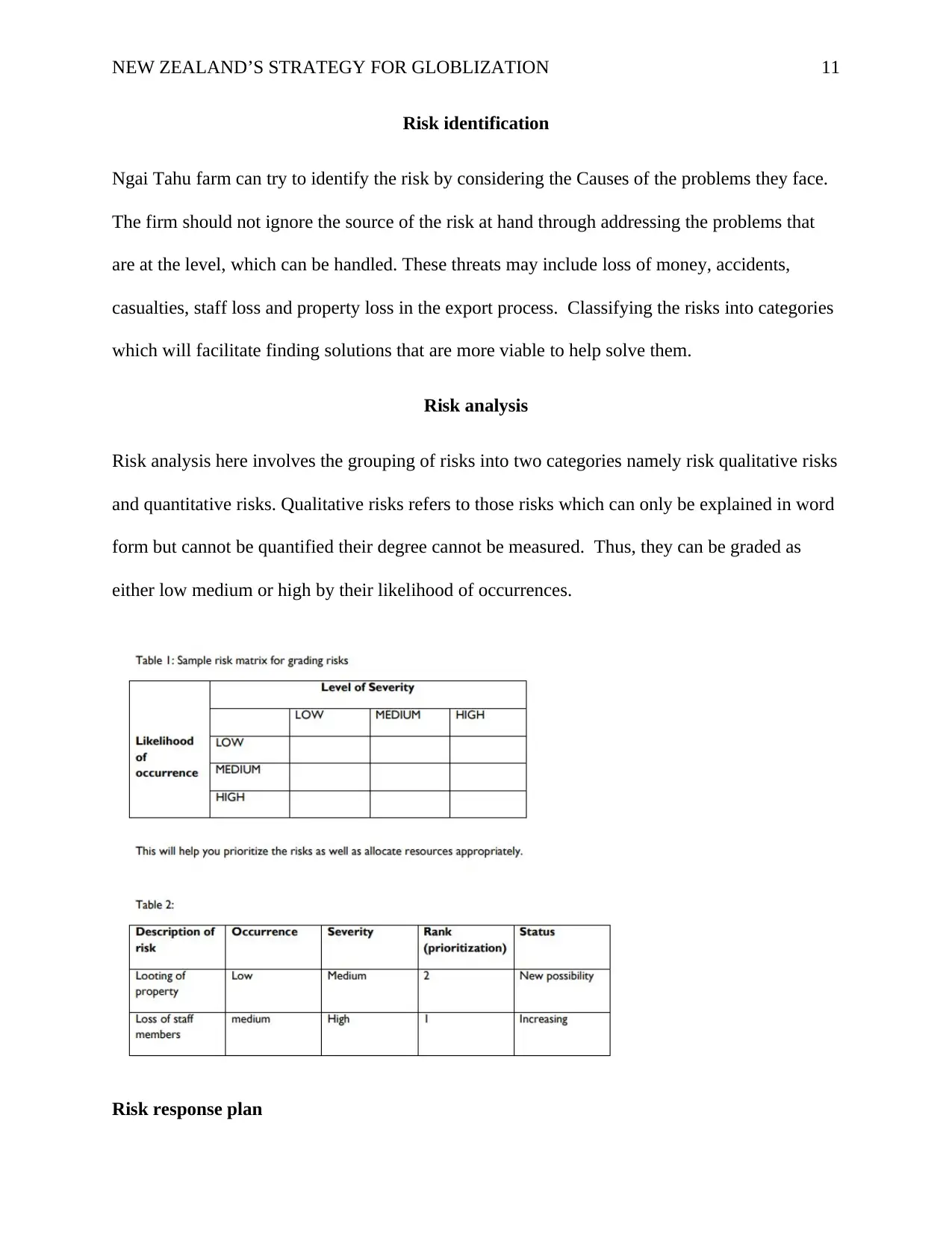
NEW ZEALAND’S STRATEGY FOR GLOBLIZATION 11
Risk identification
Ngai Tahu farm can try to identify the risk by considering the Causes of the problems they face.
The firm should not ignore the source of the risk at hand through addressing the problems that
are at the level, which can be handled. These threats may include loss of money, accidents,
casualties, staff loss and property loss in the export process. Classifying the risks into categories
which will facilitate finding solutions that are more viable to help solve them.
Risk analysis
Risk analysis here involves the grouping of risks into two categories namely risk qualitative risks
and quantitative risks. Qualitative risks refers to those risks which can only be explained in word
form but cannot be quantified their degree cannot be measured. Thus, they can be graded as
either low medium or high by their likelihood of occurrences.
Risk response plan
Risk identification
Ngai Tahu farm can try to identify the risk by considering the Causes of the problems they face.
The firm should not ignore the source of the risk at hand through addressing the problems that
are at the level, which can be handled. These threats may include loss of money, accidents,
casualties, staff loss and property loss in the export process. Classifying the risks into categories
which will facilitate finding solutions that are more viable to help solve them.
Risk analysis
Risk analysis here involves the grouping of risks into two categories namely risk qualitative risks
and quantitative risks. Qualitative risks refers to those risks which can only be explained in word
form but cannot be quantified their degree cannot be measured. Thus, they can be graded as
either low medium or high by their likelihood of occurrences.
Risk response plan
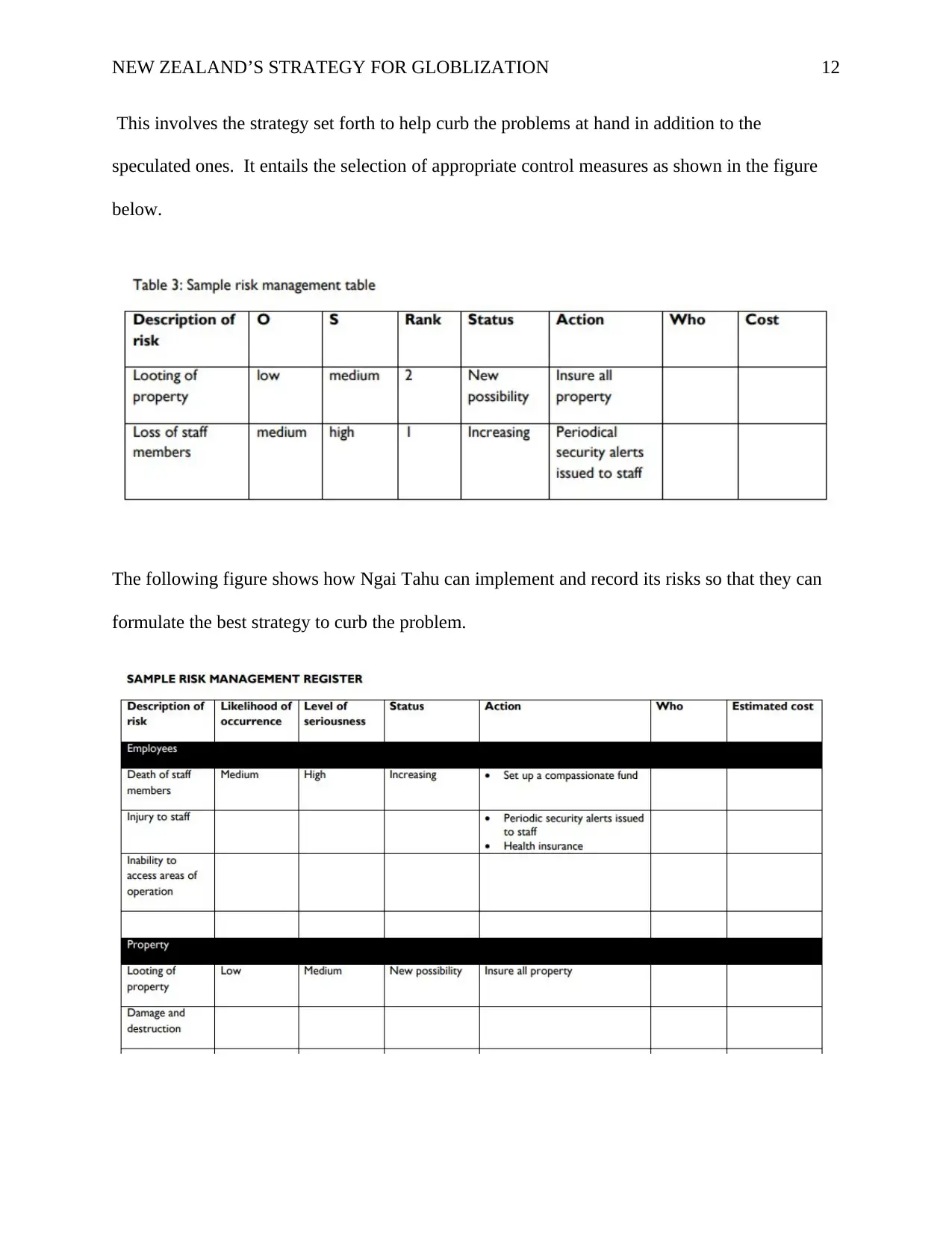
NEW ZEALAND’S STRATEGY FOR GLOBLIZATION 12
This involves the strategy set forth to help curb the problems at hand in addition to the
speculated ones. It entails the selection of appropriate control measures as shown in the figure
below.
The following figure shows how Ngai Tahu can implement and record its risks so that they can
formulate the best strategy to curb the problem.
This involves the strategy set forth to help curb the problems at hand in addition to the
speculated ones. It entails the selection of appropriate control measures as shown in the figure
below.
The following figure shows how Ngai Tahu can implement and record its risks so that they can
formulate the best strategy to curb the problem.
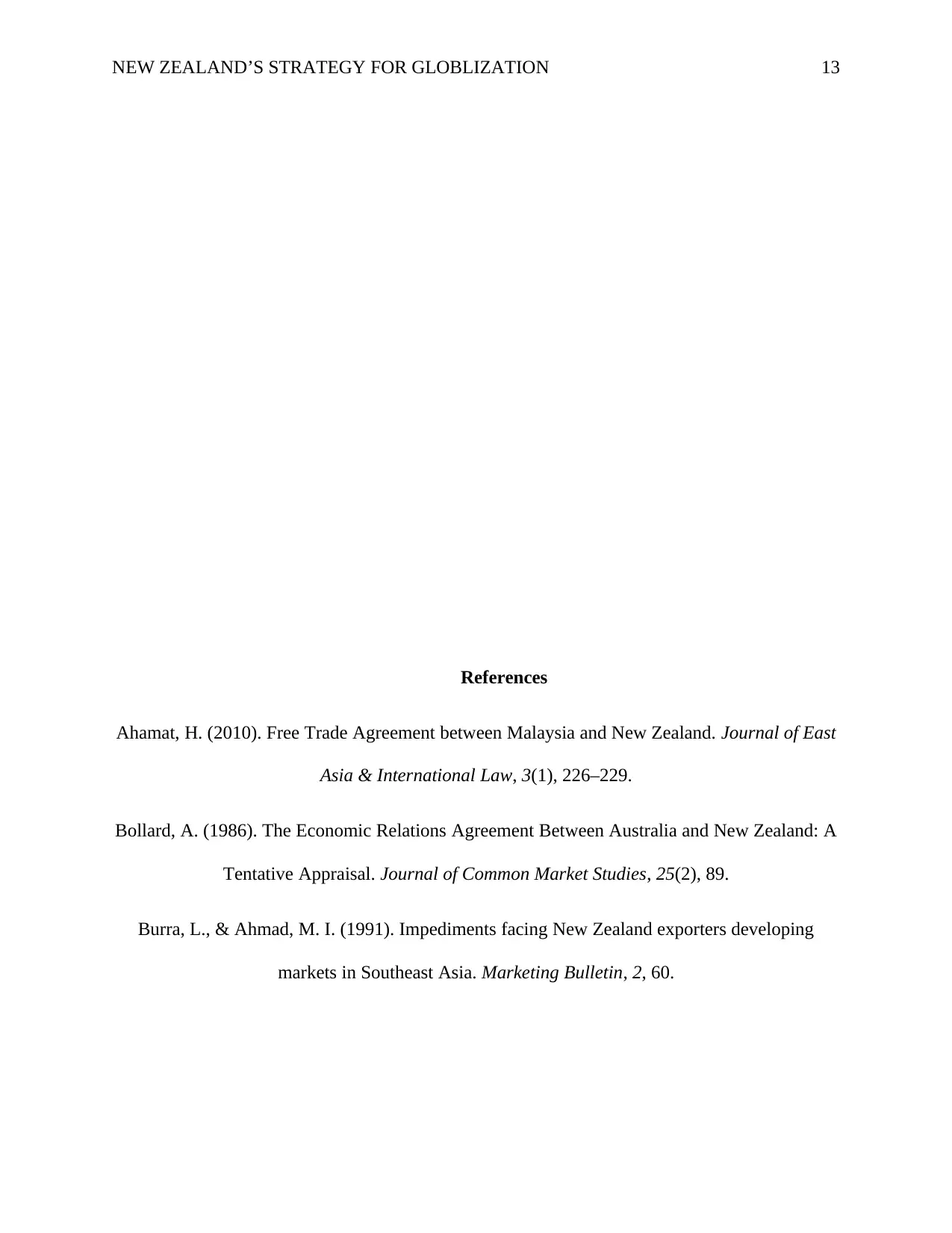
NEW ZEALAND’S STRATEGY FOR GLOBLIZATION 13
References
Ahamat, H. (2010). Free Trade Agreement between Malaysia and New Zealand. Journal of East
Asia & International Law, 3(1), 226–229.
Bollard, A. (1986). The Economic Relations Agreement Between Australia and New Zealand: A
Tentative Appraisal. Journal of Common Market Studies, 25(2), 89.
Burra, L., & Ahmad, M. I. (1991). Impediments facing New Zealand exporters developing
markets in Southeast Asia. Marketing Bulletin, 2, 60.
References
Ahamat, H. (2010). Free Trade Agreement between Malaysia and New Zealand. Journal of East
Asia & International Law, 3(1), 226–229.
Bollard, A. (1986). The Economic Relations Agreement Between Australia and New Zealand: A
Tentative Appraisal. Journal of Common Market Studies, 25(2), 89.
Burra, L., & Ahmad, M. I. (1991). Impediments facing New Zealand exporters developing
markets in Southeast Asia. Marketing Bulletin, 2, 60.
Paraphrase This Document
Need a fresh take? Get an instant paraphrase of this document with our AI Paraphraser
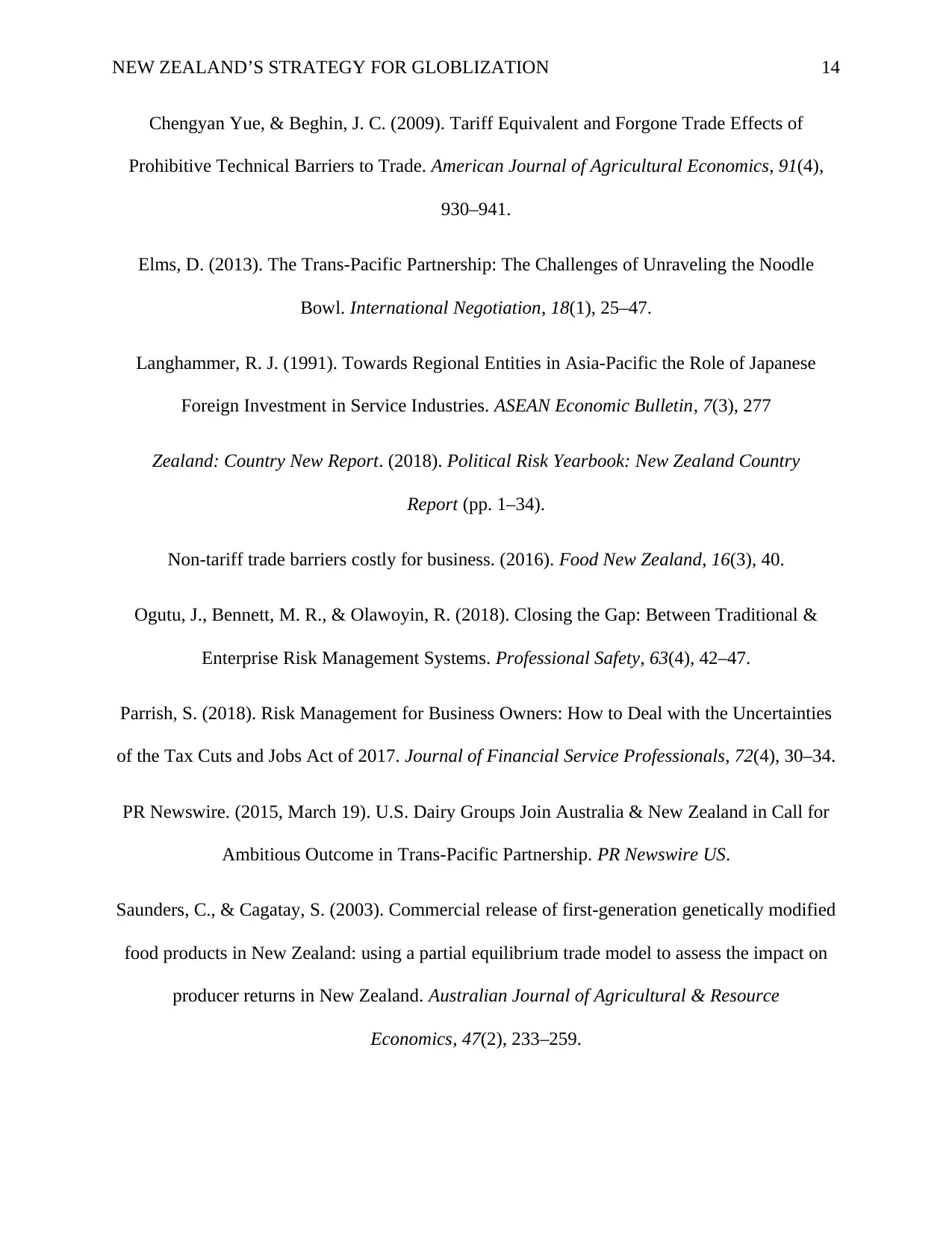
NEW ZEALAND’S STRATEGY FOR GLOBLIZATION 14
Chengyan Yue, & Beghin, J. C. (2009). Tariff Equivalent and Forgone Trade Effects of
Prohibitive Technical Barriers to Trade. American Journal of Agricultural Economics, 91(4),
930–941.
Elms, D. (2013). The Trans-Pacific Partnership: The Challenges of Unraveling the Noodle
Bowl. International Negotiation, 18(1), 25–47.
Langhammer, R. J. (1991). Towards Regional Entities in Asia-Pacific the Role of Japanese
Foreign Investment in Service Industries. ASEAN Economic Bulletin, 7(3), 277
Zealand: Country New Report. (2018). Political Risk Yearbook: New Zealand Country
Report (pp. 1–34).
Non-tariff trade barriers costly for business. (2016). Food New Zealand, 16(3), 40.
Ogutu, J., Bennett, M. R., & Olawoyin, R. (2018). Closing the Gap: Between Traditional &
Enterprise Risk Management Systems. Professional Safety, 63(4), 42–47.
Parrish, S. (2018). Risk Management for Business Owners: How to Deal with the Uncertainties
of the Tax Cuts and Jobs Act of 2017. Journal of Financial Service Professionals, 72(4), 30–34.
PR Newswire. (2015, March 19). U.S. Dairy Groups Join Australia & New Zealand in Call for
Ambitious Outcome in Trans-Pacific Partnership. PR Newswire US.
Saunders, C., & Cagatay, S. (2003). Commercial release of first-generation genetically modified
food products in New Zealand: using a partial equilibrium trade model to assess the impact on
producer returns in New Zealand. Australian Journal of Agricultural & Resource
Economics, 47(2), 233–259.
Chengyan Yue, & Beghin, J. C. (2009). Tariff Equivalent and Forgone Trade Effects of
Prohibitive Technical Barriers to Trade. American Journal of Agricultural Economics, 91(4),
930–941.
Elms, D. (2013). The Trans-Pacific Partnership: The Challenges of Unraveling the Noodle
Bowl. International Negotiation, 18(1), 25–47.
Langhammer, R. J. (1991). Towards Regional Entities in Asia-Pacific the Role of Japanese
Foreign Investment in Service Industries. ASEAN Economic Bulletin, 7(3), 277
Zealand: Country New Report. (2018). Political Risk Yearbook: New Zealand Country
Report (pp. 1–34).
Non-tariff trade barriers costly for business. (2016). Food New Zealand, 16(3), 40.
Ogutu, J., Bennett, M. R., & Olawoyin, R. (2018). Closing the Gap: Between Traditional &
Enterprise Risk Management Systems. Professional Safety, 63(4), 42–47.
Parrish, S. (2018). Risk Management for Business Owners: How to Deal with the Uncertainties
of the Tax Cuts and Jobs Act of 2017. Journal of Financial Service Professionals, 72(4), 30–34.
PR Newswire. (2015, March 19). U.S. Dairy Groups Join Australia & New Zealand in Call for
Ambitious Outcome in Trans-Pacific Partnership. PR Newswire US.
Saunders, C., & Cagatay, S. (2003). Commercial release of first-generation genetically modified
food products in New Zealand: using a partial equilibrium trade model to assess the impact on
producer returns in New Zealand. Australian Journal of Agricultural & Resource
Economics, 47(2), 233–259.
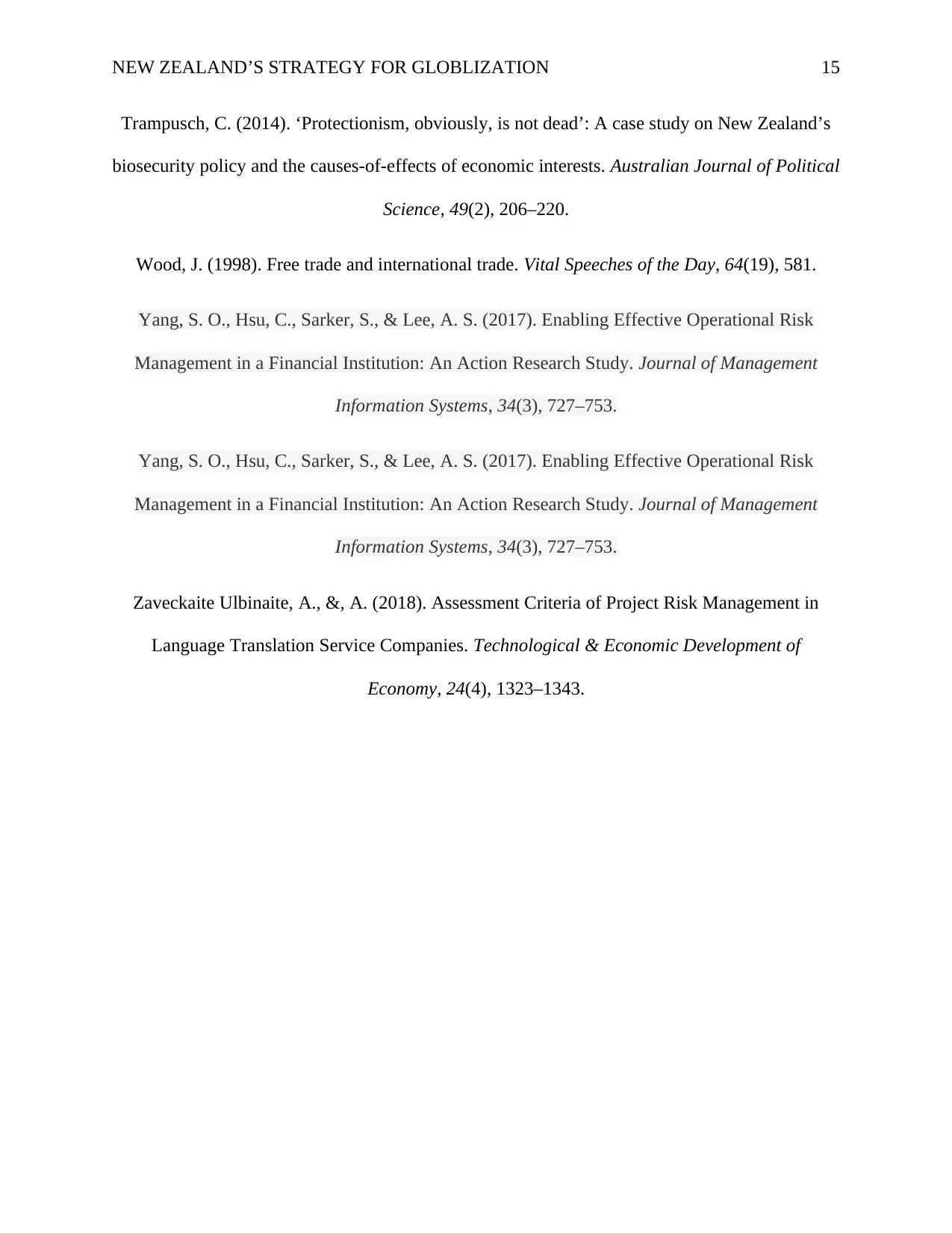
NEW ZEALAND’S STRATEGY FOR GLOBLIZATION 15
Trampusch, C. (2014). ‘Protectionism, obviously, is not dead’: A case study on New Zealand’s
biosecurity policy and the causes-of-effects of economic interests. Australian Journal of Political
Science, 49(2), 206–220.
Wood, J. (1998). Free trade and international trade. Vital Speeches of the Day, 64(19), 581.
Yang, S. O., Hsu, C., Sarker, S., & Lee, A. S. (2017). Enabling Effective Operational Risk
Management in a Financial Institution: An Action Research Study. Journal of Management
Information Systems, 34(3), 727–753.
Yang, S. O., Hsu, C., Sarker, S., & Lee, A. S. (2017). Enabling Effective Operational Risk
Management in a Financial Institution: An Action Research Study. Journal of Management
Information Systems, 34(3), 727–753.
Zaveckaite Ulbinaite, A., &, A. (2018). Assessment Criteria of Project Risk Management in
Language Translation Service Companies. Technological & Economic Development of
Economy, 24(4), 1323–1343.
Trampusch, C. (2014). ‘Protectionism, obviously, is not dead’: A case study on New Zealand’s
biosecurity policy and the causes-of-effects of economic interests. Australian Journal of Political
Science, 49(2), 206–220.
Wood, J. (1998). Free trade and international trade. Vital Speeches of the Day, 64(19), 581.
Yang, S. O., Hsu, C., Sarker, S., & Lee, A. S. (2017). Enabling Effective Operational Risk
Management in a Financial Institution: An Action Research Study. Journal of Management
Information Systems, 34(3), 727–753.
Yang, S. O., Hsu, C., Sarker, S., & Lee, A. S. (2017). Enabling Effective Operational Risk
Management in a Financial Institution: An Action Research Study. Journal of Management
Information Systems, 34(3), 727–753.
Zaveckaite Ulbinaite, A., &, A. (2018). Assessment Criteria of Project Risk Management in
Language Translation Service Companies. Technological & Economic Development of
Economy, 24(4), 1323–1343.
1 out of 15
Related Documents
Your All-in-One AI-Powered Toolkit for Academic Success.
+13062052269
info@desklib.com
Available 24*7 on WhatsApp / Email
![[object Object]](/_next/static/media/star-bottom.7253800d.svg)
Unlock your academic potential
© 2024 | Zucol Services PVT LTD | All rights reserved.



